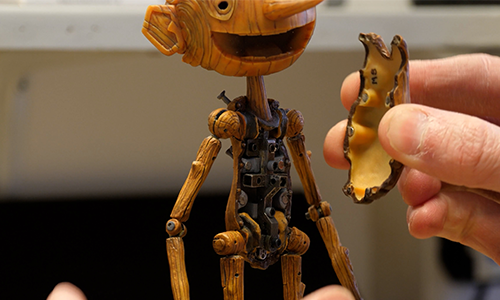Did you know that the stop-motion puppetry featured in Guillermo del Toro’s 2022 film Pinocchio was accomplished through the use of metal 3D printing? Our story begins in the year 2008, when del Toro envisioned a unique animated experience for his story. He reached out to Mackinnon & Saunders, a company well-known for their puppet designs. If you’ve ever seen The Corpse Bride, The Fantastic Mr. Fox, or Bob the Builder, you’ve seen their work in action.
Del Toro wanted to shift away from the conventional approach of employing countless casted puppet iterations. A single figure equipped with moveable joints would be much easier and more practical to film. Unfortunately, the kind of puppet the acclaimed director wanted was simply not possible to construct with the technology available at the time.
In 2020, 12 years later, everything changed. No, not those changes. Rather, additive manufacturing technology had advanced to the point that Guillermo’s vision could finally become a reality. For assistance, Mackinnon & Saunders contacted a longtime partner, Laser Prototypes Europe (LPE), a Northern Irish firm with decades of 3D printing experience for the film industry.
“Due to the fact that they were mechanizing the puppets and making them into essentially miniature robots, the requirement from the outset was for metals over plastics.” said Patrick Walls, engineering director at LPE. “That’s why we chose stainless steel, to ensure that the puppet wouldn’t deflect when it moved and there wouldn’t be a bending force.”
The teams collaborated on the design of a hollow-bodied puppet that would be fitted with internal mechanisms to enable the movement of its limbs. A crew of five was needed to remove supports, sand rough edges, and assemble the props. If you’ve used 3D printers for any amount of time, you’ve probably got a story about annoying supports marring the final quality of a print. Just imagine having to work out those kinks for something destined for the scrutinizing eyes of Hollywood audiences.
“We had to develop a protocol as to how they were hand finished to make sure that each of the team members was sanding and removing support structures in such a way as to avoid bringing up lines or marks. It was meticulous, slow and methodical, but we got there in the end!” explained Walls.
The Mlab metal printer from GE Additive played a crucial role in the project. Utilizing a100 watt laser, the Mlab was able to produce highly detailed, uniform, interlocking metallic pieces for the puppets. While GDT and the team at Mckinnon & Saunders were impressed with what the Mlab could produce, they still feared that it wouldn’t be able to capture the desired woodgrain effect for the outer shell of the puppet. Those fears were quickly put to bed.
McKinnon & Saunders and del Toro weren’t the only ones pleased with the outcome—so was the Academy of Motion Picture Arts and Sciences. Pinocchio won the Oscar for best animated film in 2023. While AM has been used for stop-motion films before, most notably by LAIKA, this was the first time that 3D printing enabled the creation of such a complex prop. Laser Prototypes Europe expressed pride in the collaboration with GE Additive, recognizing it as a step towards the future of cinema. It’s not just movie magic; it’s a glimpse into the intriguing possibilities of innovative technology in filmmaking.
Subscribe to Our Email Newsletter
Stay up-to-date on all the latest news from the 3D printing industry and receive information and offers from third party vendors.
You May Also Like
Further Understanding of 3D Printing Design at ADDITIV Design World
ADDITIV is back once again! This time, the virtual platform for additive manufacturing will be holding the first-ever edition of ADDITIV Design World on May 23rd from 9:00 AM –...
3D Printer Maker EVO-tech Reborn as NEVO3D — Once More With Feeling
EVO-tech was a 3D printing service and original equipment manufacturer established in 2013 and based in Schörfling am Attersee, Austria. The company produced high-quality material extrusion systems featuring linear bearings,...
3D Systems Brings 3D Printed PEEK Cranial Implant to the U.S. with FDA Clearance
For more than 10 years, 3D Systems (NYSE:DDD) has worked hand-in-hand with surgeons to plan over 150,000 patient-specific cases, and develop more than two million instruments and implants from its...
CDFAM Returns to Berlin for Second Annual Symposium
The second CDFAM Computational Design Symposium is scheduled for May 7-8, 2024, in Berlin, and will convene leading experts in computational design across all scales. Building upon the first event...

































